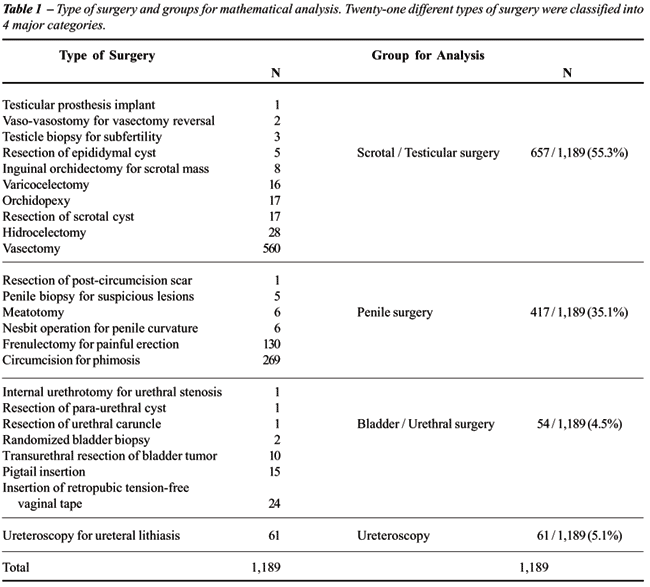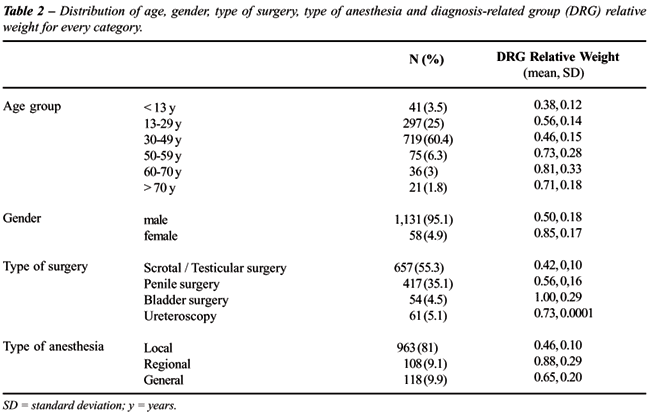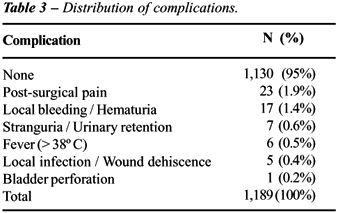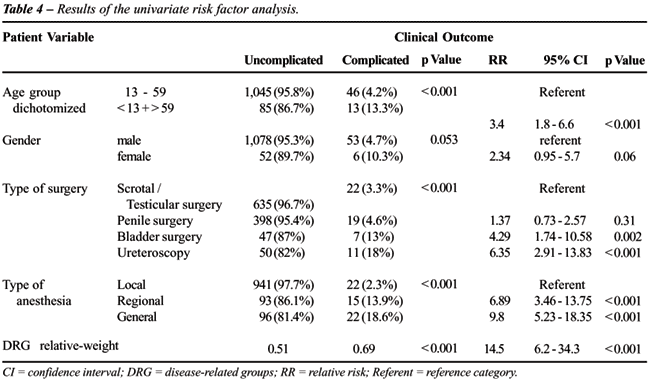ADVERSE
EVENTS AND READMISSIONS AFTER DAY-CASE UROLOGICAL SURGERY
(
Download pdf )
ALVARO PAEZ, ENRIQUE REDONDO, ANA LINARES, EMILIO RIOS, JORGE VALLEJO, MARGARITA SANCHEZ-CASTILLA
Department of Urology (AP, ER, AL, ER, JV) and Department of Anesthesia (MSC), Hospital De Fuenlabrada, Madrid, Spain
ABSTRACT
Objective:
The literature lacks of studies on postoperative outcomes after urological
ambulatory surgery. Our study aims to identify parameters associated with
postoperative complications within 30 days after ambulatory urological
surgery.
Materials and Methods: Adjusted and unadjusted
comparisons between clinical features and postoperative outcome (complicated
and uncomplicated).
Results: Postoperative course was complicated
in 5% of the patients. Discharge schedule was not completed in 1.1% while
unplanned visits resulted in admission in 0.5%. Multivariate analyses
could only confirm the independent effect of type of anesthesia and diagnosis-related
group (DRG) relative weight.
Conclusions: Ambulatory urological surgery
can be safe in terms of postoperative complications. In the present study
surgery under general anesthesia, or a higher DRG relative weight procedure,
increased the risk of complications compared to surgery under regional
or local anesthesia or lower DRG relative weight operations. Patients
scheduled for general anesthesia or undergoing complex urological procedures
should be warned about an increased risk of postoperative incidents and/or
readmission.
Key
words: ambulatory surgical procedures; anesthesia; treatment
outcome
Int Braz J Urol. 2007; 33: 330-8
INTRODUCTION
Ambulatory
surgery represents more than 60-70% of all surgical procedures performed
in the United States (1). Considering the extraordinary progress experienced
in minimally invasive techniques, this trend will increase during the
next years and will probably spread to most surgical specialties. Among
modern urologists, there is a growing recognition that many well-established
urological procedures may be performed in an ambulatory setting (2). Nevertheless,
urological procedures - particularly low-complexity interventions like
varicocelectomy and hydrocelectomy - have been identified as an independent
risk factor for postoperative complications (3).
Most publications addressing the outcomes
of ambulatory surgery reflect observations during patients’ stay
or within the first 2-3 days after hospital discharge (4,5). This retrospective
study aims to identify parameters associated to postoperative complications
within 30 days after ambulatory urological surgery.
MATERIALS AND METHODS
For
this study, the files of all patients undergoing elective ambulatory urological
surgery throughout a 16-month period in a single public centre were reviewed.
After the pre-operative urological work-up, and once the type of procedure
was agreed with the patient, the discharge terms were clarified, paying
special attention to those operations requesting an indwelling catheter
at discharge (internal urethrotomy for urethral stenosis and resection
of female para-urethral cyst).
All patients scheduled for major procedures
underwent a pre-anesthesia visit preoperatively. Peripheral blood samples
were obtained for cell count and determination of serum concentrations
of glucose, total protein, creatinine, sodium, and potassium. Coagulation
status was not routinely tested. An electrocardiogram was performed in
patients over 45 years-old. Type of anesthesia was planned in this visit
and informed consent was obtained for the procedure.
Only poor-risk cases (ASA 3 or higher) were
excluded and operated as inpatients. No age limits were applied. All pediatric
patients ( < 11 years) were operated under general anesthesia (GA);
a minimum weight of 15 kg was used as inclusion criterion in these cases.
General intravenous anesthesia with propofol
and remifentanil was the preferred technique also for adult patients undergoing
major procedures; drugs were delivered via a TCI (Target Controlled Infusion)
pump with target effect in the range of 2-6 mcg/mL for propofol and 5-10
ng/mL for remifentanil. Airway was secured with a laryngeal mask. In pediatric
patients, an inhalational technique supplemented with fentanyl was chosen.
Regional anesthesia was performed by the
intrathecal route with small gauge (25-27) pencil point needles in the
sitting position and an average of 1.5 mg per dermatome of hyperbaric
bupivacaine. Fentanyl ≤ 20 mcg was added for transurethral procedures.
Typically, patients were sequentially admitted
early in the morning, operated and discharged when pain was controlled,
and micturition and ambulation confirmed. Perioperative pain was evaluated
using a visual analog scale (VAS 0 to 10) at arrival in the recovery unit
and every 30 minutes. Low-intensity pain (VAS < 3) deserved no analgesia.
The standardized treatment for moderate pain (VAS 4-6) was the endovenous
administration of a non-steroidal anti-inflammatory drug (NSAID): metamizole
2 g or ketorololac 30 mg or propacetamol 2 g. Severe perioperative pain
(VAS > 7) included the association of endovenous major opioids (fentanyl
0.5-1 µg/kg or morphine 0.03-0.05 mg/kg or alfentanil 3-5 µg/kg). Standard
analgesic treatment at discharge was oral metamizole (500 mg qd), paracetamol
(500 mg qd) or ibuprofen (400-600 mg qd). Management of low to moderate
perioperative pediatric pain deserved endorectal metamizole (40 mg/kg
qd), oral (15 mg/kg qd) or endorectal paracetamol (25 mg/kg qd), or oral
ibuprofen (5-10 mg/kg qd). For severe pain, oral tramadol (0.5-1 mg/kg
qd) was associated.
For a safer discharge, pigtail catheters
(double J) were routinely inserted after ureteroscopy and removed one
week later under local anesthesia in the outpatient clinic. Female stress
urinary incontinence was treated using retropubic tension-free vaginal
tapes. As a general policy, and irrespectively of the procedures, drainages
were removed before discharge. When needed patients were instructed about
wound and/or sound care. Staff urologists and anesthesiologists were permanently
available (round-the-clock).
For the present study, clinical data (age
and gender, type of surgery and anesthesia) were downloaded from the electronic
patient record (EPR, Selene, Siemens®). For mathematical analysis,
all 21 different types of surgery (Table-1) were grouped into four major
surgical categories (testicle/scrotum, penis, bladder and ureteroscopy).
Diagnosis-Related Group (DRG) relative-weight was used as index of clinical
complexity. The DRG system (6) classifies hospital cases into one of approximately
500 groups expected to have similar hospital resource use. DRG relative
weights translate the case-mix of patients treated across hospitals.

Postoperative course was the primary outcome
measure; for analysis it was considered either uncomplicated (discharge
before 10 pm and absence of unplanned visits to outpatients clinic or
emergency ward) or complicated (failure to complete the discharge schedule
and/or unplanned visits).
An algorithm was created in the EPR to identify
the reasons for delaying hospital discharge or warranting unexpected visits
to the emergency ward or outpatient clinic within 30 days after surgery.
To identify patients more prone to suffer
postoperative complications, univariate comparisons between clinical features
and postoperative outcome (uncomplicated or complicated) were performed
using the Pearson´s chi square and Mann-Withney U tests. Relative
risks (RR) for complicated postoperative course were calculated adjusted
to every prognostic factor.
To further approach the effect of every
variable in the presence of the rest of covariates, logistic regression
models were used, taking the postoperative outcome (uncomplicated or complicated)
as the dependent variable. Additionally, all inpatient admissions were
recorded.
Statistical analyses were performed using
the SPSS v11.5 statistical software.
A level of significance of 95% (p < 0.05)
was used for all comparisons.
RESULTS
Throughout
the study period, 1,420 consecutive patients were operated on an outpatient
basis. Since structured electronic databases were implemented some months
after the implementation of day-case urological surgery, only 1,189 cases
(95.1% men, 4.9% women, mean age 35.3 years, SD 13.1) were available for
analysis. Procedures on testicle/scrotum represented 55.3% (657/1,189)
of the total number of interventions, while penile surgery accounted for
35.1% (417/1,189) of all ambulatory operations; ureteroscopy and bladder
surgery accounted for 5.1% (61/1,189) and 4.5% (54/1,189) of all ambulatory
procedures, respectively (Table-1). We used age as a categorical rather
than a continuous variable since the association between age and outcome
was not linear but bimodal, thus resulting in two risk groups: low risk
(13-59 years) and high risk (older than 59 years + younger than 13 years).
Table-2 shows patient characteristics, type
of surgery, anesthesia and average DRG relative-weight for every category.

Postoperative course was complicated in
59 patients (59/1,189, 5%). Admission of outpatients was decided in 0.5%
(6/1,189) and discharge postponed in 1.1% (13/1,189). The remaining 3.4%
presented to the outpatient clinic or emergency ward and could be immediately
discharged. Median time to the unplanned visit was 9 days. Post-surgical
pain and bleeding or hematuria accounted for the vast majority of complications
(40/59, 67.8%). Table-3 shows the distribution of complications.

Age acted as a prognostic factor, with patients
< 13 and > 60 years old being more exposed to complicated postoperative
courses (chi square < 0.001). RR for this category was 3.4 (95% CI
1.8-6.6, p < 0.001); in other words, the probability of suffering a
complicated postoperative course was almost 3.5 times higher for patients
< 13 and > 60 years old when compared with patients aged 13-59 years
(referent category).
A clear although non-significant trend towards
more complicated postoperative courses was detected among women operated
as day cases (chi square = 0.053, RR 2.34, 95% CI .95-5.7, p = 0.06).
A clear grading in terms of procedure-related postoperative complications
was evident, being testis/scrotum surgery (reference category) associated
with the lowest rate of adverse events (22/657, 3.3%), whereas increased
rates were observed for penile surgery (19/417, 4.6%, RR 1.37, 95% CI
.73-2.57, p = 0.31), bladder surgery (7/54, 13%, RR 4.29, 95% CI 1.74-10.58,
p = 0.002) and ureteroscopy (11/61, 18%, RR 6.35, 95% CI 2.91-13.83, p
< 0.001).
GA resulted in the highest proportion of
complicated postoperative courses when compared to regional or local anesthesia
(chi square < 0.001). The risk of postoperative complications following
regional anesthesia was 6.89-fold (RR 6.89, 95% CI 3.46-13.75, p <
0.001) that of local anesthesia (reference category). Surgery under GA
had a risk of postoperative complications almost 10-fold higher than surgery
using local anesthesia (RR 9.8, 95% CI 5.23-18.35, p < 0.001).
Complicated postoperative courses had an
average DRG relative-weight of 0.69 while uncomplicated cases averaged
0.50 (Mann-Withney U test < 0.001). During the univariate analysis,
every DRG relative-weight unit multiplied times-14.5 (RR 14.5, 95% CI
6.2-34.3, p < 0.001) the risk of a complicated postoperative course.
Table-4 summarizes this phase of the study.

Multivariate analyses could only confirm
the independent effect of type of anesthesia and DRG relative-weight.
The final model revealed that a hierarchy existed in terms of anesthesia-related
complications, with GA resulting in the highest rate of complications
(RR 7.6, 95% CI 3.8-15, p = 0.003) when compared to the reference category
(local anesthesia). Also, DRG relative-weight acted as an independent
prognostic factor: every DRG relative-weight unit multiplied times-3.3
(RR 3.3, 95% CI 1.003-11.4, p = 0.049) the risk of a complicated postoperative
course. Predictive regression models are presented in Table-5.

In 19 cases inpatient admission was eventually
decided (6/1,189, 0.5%) or discharge was postponed (13/1,189, 1.1%).
COMMENTS
Although
there may be the misconception that ambulatory surgery only deals with
minor procedures, the reality is that a wide variety of procedures is
commonly performed: in the authors’ institution more than 20 different
open surgical and endoscopic urologic procedures are routinely performed
as day-surgery cases with an average case-mix (mean DRG relative-weight)
of 0.52. Overall, ambulatory surgery represents more than 80% of the surgical
activity in this department were the global DRG relative-weight is 1.38.
So far, the results can be considered satisfactory
with 95% of patients completing the discharge schedule and not needing
any unplanned visit. Similarly, 1.1% of the patients could not be discharged
while 0.5% had to be readmitted as a result of complications. These rates
are consistent with other studies (7-9). The rate of mortality associated
with anesthesia and surgery in the outpatient setting has been estimated
to be 0.25 to 0.50 per 100,000 outpatient procedures (7,9). As expected,
no deaths were identified in the present study (mean patients age 35 yrs).
This finding is also comparable with results published elsewhere (8-12),
and translate the levels of safety achieved in ambulatory surgery (4,13).
This study identified two factors affecting
the complication rate related to ambulatory urologic surgery: the rate
of postoperative complications was strongly dependent on DRG relative-weight
and type of anesthesia. Patient-specific factors have been previously
identified as important predictors of adverse events: advanced age (>
85 years) and comorbidity have been associated with increased risk of
inpatient hospital admission (12,14). Also, type of surgery (urological
surgery, among others) has been confirmed as a risk factor elsewhere (3,15).
In our study, age, while acting as a risk factor during the univariate
analysis, could not be confirmed as independent risk factor during the
multivariate analysis. Nevertheless, it is remarkable that a bimodal curve
of risk was identified, with younger (< 13 yrs) and elder patients
(> 60 yrs) being markedly exposed to postoperative complications. In
spite of accounting for the lowest clinical complexity (mean DRG relative-weight
0.38, SD 0.12) younger patients experienced the vast majority of complicated
postoperative courses. We hypothesize that parents’ expectations
can sometimes exceed the performance of ambulatory surgery in the pediatric
setting thus resulting in an elevated number of delayed discharges and
unplanned visits to the hospital. Anyway, children are considered to be
excellent candidates for day-case surgery. Pediatric outpatient surgery
has been proposed from the age of 4 months (16), and the benefits of a
short hospitalization probably justify the modest risk of postoperative
incidents and/or hospitalization (17).
Type of surgery (testicle/scrotum, penis,
bladder and ureteroscopy, in this study), while a friendly parameter to
clinicians, could not be confirmed as a prognostic variable. In other
words, the grouping of surgical procedures used in this study could be
sensible for surgical planning but was not helpful to foresee risky operations
(in terms of postoperative incidents). On the contrary, we observed an
increased risk of postoperative complications associated to clinical complexity
as defined by the DRG relative-weight system. It is conceivable that technically
demanding procedures can result in postoperative complications but post-surgical
outcome is multifactorial with many variables involved. This is the reason
why we decided to test the ability of DRG relative-weight to discriminate
between patients at risk and not at risk. So far it has been proved that
the use of the DRG-system positively affects length of stay (LOS), operative
blood loss, transfusion rates, operative margins and postoperative complications,
resulting in a higher efficiency (18,19). As far as we know, the DRG relative-weight
system has not been used as a prognostic factor for postoperative complications.
The effect of anesthesia on postoperative
outcome has been widely studied (20). In a vast study of 17,638 patients,
there were no anesthesia-related admissions or deaths (10). The type of
surgery plays a major role in increasing the postoperative LOS; clearly,
urologic patients have longer LOS than those undergoing ophthalmologic
surgery (21). In the present study, type of anesthesia (GA) acted as a
risk factor for postoperative complications (in terms of discharge and
readmission rates) after ambulatory surgery. It is of interest the fact
that the level of surgical complexity (in terms of DRG relative-weight)
was higher for the group operated under regional anesthesia while patients
undergoing GA suffered the vast majority of complications. GA-related
side effects probably explain such effect. It is intriguing since a recent
experience in healthy men undergoing minor genitourinary procedures proved
that GA with remifentanil and propofol was as safe and effective anesthesia
as spinal block with the advantage of a faster discharge (22).
Our study has several limitations: the accuracy
of our analysis might be biased by its retrospective nature. In addition
postoperative complications could be underestimated given no information
on visits to general practitioners is available. Other limitations include
small sample sizes for ureteroscopy and bladder surgery, and an uneven
gender distribution (markedly biased towards male surgery). Also, a number
of different procedures was grouped thus making impossible a detailed
procedure-specific analysis. From the procedural point of view, we accept
that the use of pigtail catheters after uncomplicated ureteroscopy can
be arguable (23,24). Nevertheless, our standard is ureteral dilation before
the ureteroscope insertion. In this particular setting pig-tails can be
warranted (23).
Now, let us be practical. What can be done
to improve the performance of day-case urology? Unfortunately, the type
of surgery and surgical complexity are factors that cannot be altered
preoperatively, while the need for GA cannot be easily modified. Nevertheless
patient and staff education offer a window of opportunity for improving
the success rate of day-surgery. It has been suggested that the success
of ambulatory surgery depends on how attractive it can be for the patient
(25). We believe that it also has to be appealing for health-professionals;
in the authors’ experience upfront procedural information to medical-staff
(surgeons, anesthesiologists, nurses and ancillary staff) and patients
is vital: the terms of discharge must be clear before patients are included
in the waiting list. Otherwise, reasons for delayed discharge can always
be identified.
CONCLUSIONS
Ambulatory urological surgery can be safe in terms of postoperative complications and readmissions. Independently of other clinical factors (age, gender, type of surgery and surgical complexity), surgery under general anesthesia represents a risk factor for postoperative complications and readmission. Similarly, complex procedures (in terms of DRG relative weight) increase the risk of complications compared to low complexity operations. Whenever possible, surgery under regional and/or local anesthesia should be encouraged.
CONFLICT OF INTEREST
None declared.
REFERENCES
- Owings MF, Kozak LJ: Ambulatory and inpatient procedures in the United States, 1996. Vital Health Stat. 1998; 139: 1-119.
- Mohamed M, Hollins G, Eissa M: Experience in performing pyelolithotomy and pyeloplasty in children on day-surgery basis. Urology. 2004; 64: 1220-3.
- Twersky R, Fishman D, Homel P: What happens after discharge? Return hospital visits after ambulatory surgery. Anesth Analg. 1997; 84: 319-24.
- Duncan PG, Cohen MM, Tweed WA, Biehl D, Pope WD, Merchant RN, et al.: The Canadian four-centre study of anaesthetic outcomes: III. Are anaesthetic complications predictable in day surgical practice? Can J Anaesth. 1992; 39: 440-8.
- Liu LL, Leung JM: Predicting adverse postoperative outcomes in patients aged 80 years or older. J Am Geriatr Soc. 2000; 48: 405-12.
- Diagnosis Related Groups (DRGs) and the Medicare Program: Implications for Medical Technology – A Technical Memorandum (Washington, D.C.: U.S. Congress, Office of Technology Assessment, OTA-TM-H-17, July 1983).
- Eichhorn JH: Prevention of intraoperative anesthesia accidents and related severe injury through safety monitoring. Anesthesiology. 1989; 70: 572-7.
- Mezei G, Chung F: Return hospital visits and hospital readmissions after ambulatory surgery. Ann Surg. 1999; 230: 721-7.
- Shnaider I, Chung F: Outcomes in day surgery. Curr Opin Anaesthesiol. 2006; 19: 622-9.
- Millar JM: US ambulatory surgery projections are inappropriate. Ambul Surg. 1997; 5: 121-4.
- Fleisher LA, Pasternak LR, Herbert R, Anderson GF: Inpatient hospital admission and death after outpatient surgery in elderly patients: importance of patient and system characteristics and location of care. Arch Surg. 2004; 139: 67-72.
- Morello DC, Colon GA, Fredricks S, Iverson RE, Singer R: Patient safety in accredited office surgical facilities. Plast Reconstr Surg. 1997; 99: 1496-500.
- Natof HE: Complications associated with ambulatory surgery. JAMA. 1980; 244: 1116-8.
- Marcantonio ER, McKean S, Goldfinger M, Kleefield S, Yurkofsky M, Brennan TA: Factors associated with unplanned hospital readmission among patients 65 years of age and older in a Medicare managed care plan. Am J Med. 1999; 107: 13-7.
- Coley KC, Williams BA, DaPos SV, Chen C, Smith RB: Retrospective evaluation of unanticipated admissions and readmissions after same day surgery and associated costs. J Clin Anesth. 2002; 14: 349-53.
- Kalfa N, Forgues D, Rochette A, Lopez M, Guibal MP, Sabatier-Laval E, et al.: [A comparative study of the feasibility and limits of ambulatory surgery in infants under and over one year of age][French]. Ann Chir. 2004; 129: 144-8.
- Minatti WR, Benavides F, Capelino P, Ramos R, Premoli G and Statti M: Postdischarge unplanned admission in ambulatory surgery-a prospective study. Ambul Surg. 2006; 12: 107-112.
- Schwartz MH, Tartter PI: Decreased length of stay for patients with colorectal cancer: implications of DRG use. J Healthc Qual. 1998; 20: 22-5.
- Collier PE: Fast tracking carotid endarterectomy: practical considerations. Semin Vasc Surg. 1998; 11: 41-5.
- Deutsch N, Wu CL: Patient outcomes following ambulatory anesthesia. Anesthesiol Clin North America. 2003; 21: 403-15.
- Chung F, Mezei G: Factors contributing to a prolonged stay after ambulatory surgery. Anesth Analg. 1999; 89: 1352-9.
- Erhan E, Ugur G, Anadolu O, Saklayan M, Ozyar B: General anaesthesia or spinal anaesthesia for outpatient urological surgery. Eur J Anaesthesiol. 2003; 20: 647-52.
- Byrne RR, Auge BK, Kourambas J, Munver R, Delvecchio F, Preminger GM: Routine ureteral stenting is not necessary after ureteroscopy and ureteropyeloscopy: a randomized trial. J Endourol. 2002; 16: 9-13.
- Denstedt JD, Wollin TA, Sofer M, Nott L, Weir M, D’A Honey RJ: A prospective randomized controlled trial comparing nonstented versus stented ureteroscopic lithotripsy. J Urol. 2001; 165: 1419-22.
- Calle JE, Parra P, Gomis R, Ramón T and San Eustaquio F: Use of the substitution index to identify improvement opportunities in major ambulatory surgery. Ambul Surg. 2006; 12: 159-166.
____________________
Accepted
after revision:
January 12, 2007
_______________________
Correspondence address:
Dr. Alvaro Paez
Servicio de Urologia
Hospital de Fuenlabrada
C. del Molino 2
28942, Fuenlabrada, Madrid, Spain
Fax: + 349 1600-6186
E-mail: apaez.hflr@salud.madrid.org